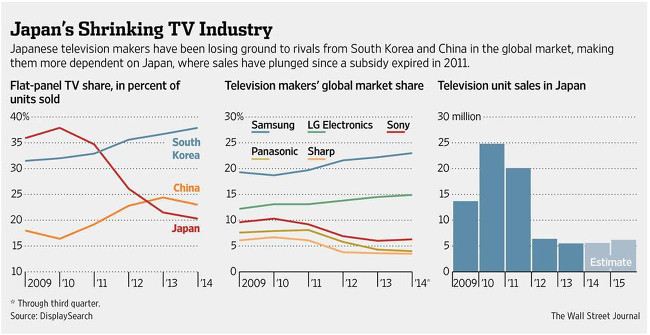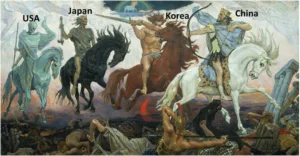Will TV live past China?
by Dr Jon Peddie

Philo T. Farnsworth invented Electronic TV in the US and demonstrated it on September 7, 1927, in Los Angeles. In Scotland in 1926, John Logie Baird demonstrated a mechanical scanning disc television set. And before that Vladimir Kosmich Zworykin filed a patent on December 29, 1923, “Television Systems”, although the equipment described was never successfully demonstrated.
The U.S. rises
After WWII, TV took off in the US, while Europe and Asia rebuilt. From 1939 until today, there have been over 220 television set manufacturers that made sets in and or for the USA market.
The U.S. declines
Some of the well-known American brands were Admiral, General Electric, Magnavox, Motorola, Philco, RCA, Silvertone, Westinghouse, Zenith. According to the New York Times, more than 90 US companies made TV sets. By the 1970s, the US had only a few TV manufactures left.
Enter the Japanese
In 1953, Sharp produced the first Japanese electronic post-war TV. By the late 1970s, the Japanese dominated the market and US consumers switched to Panasonic, Toshiba, Sony, Sharp and other Japanese brands that were offering superior quality at a better price. One by one, the US manufacturers disappeared. In 1995, the last remaining US television company, Zenith, was sold to Korea’s LG Electronics.
Korea rises
In 1966, Goldstar (now LG) produced Korea’s first black & white TV. The first TV released by Samsung Electronics was a 12″, black-and-white set in 1970.
Japan declines
Following its decision to not show new TVs at International CES in January this year, Toshiba has officially announced that it will stop making TVs for North America and will consider similar pullouts elsewhere.
Last week The Wall Street Journal published these charts.
 Japanese TV makers retreat from overseas markets (Source WSJ)
Japanese TV makers retreat from overseas markets (Source WSJ)
As the Japanese reduce their marketing reach, the Koreans will face a similar dilemma.
TV sales are slowing in growth, less than population or GNP growth, and is mostly a replacement market. The industry is counting on 4k to be the boost needed.
 Forecast for LCD TV, Plasma TV and CRT TV Unit Shipments (Source: NPD DisplaySearch)
Forecast for LCD TV, Plasma TV and CRT TV Unit Shipments (Source: NPD DisplaySearch)
 Early television in US (source http://www.tvhistory.tv/1960-2000-TVManufacturers.htm)The slowing of worldwide TV sales will affect Korean TV set manufacturers who have over extended their investment in TV manufacturing.
Early television in US (source http://www.tvhistory.tv/1960-2000-TVManufacturers.htm)The slowing of worldwide TV sales will affect Korean TV set manufacturers who have over extended their investment in TV manufacturing.
The rise of China
Ultra HD 4k TVs are being touted as the next big thing, but it’s a resolution revolution that’s going to be largely fought not in Europe or North America, but in China. China remains the focal point for 4k TV unit volume growth, accounting for more than 60% of global 4k TV shipments in Q3’14.
A new set of TV manufacturers from China are emerging, companies such as TCL, Hisense, Haier, Konka and Skyworth as well as brands like Seiki.
New US TVs
Meanwhile, the US has seen two TV companies emerge. Element Electronics of Eden Prairie, Minn. The company is “American-owned,” it proudly declares, and its products are totally “American-assembled”. Element began production of flat-screen TVs in March 2012 in a factory in Detroit.
Vizio is an American privately held producer of consumer electronics, based in Irvine, California. It was founded in October 2002. Vizio’s major partner in the consumer electronics arena is AmTran Technology, a Taiwan-based OEM/ODM that manufactures more than half of the televisions sold by Vizio.
However, the long-prognosticated death of TV may be happening before our eyes – but at a glacial pace. A new in-depth report from tracking firm Nielsen shows that TV is still by far America’s favorite entertainment past-time, but individuals are spending more hours surfing web and viewing streaming services. A growing number of households are choosing to dump TV altogether.
As the center of gravity shifts from Japan and Korea to China, China may find itself selling to a home market while TV watching elsewhere, and in China decline. Now what was that old Chinese proverb, “Be careful what you…..”
Jon Peddie
Another Point?
Now, my good friend Jon yields to nobody in his love of things European! However, I couldn’t help wanting to mention that Karl Ferdinand Braun, at the University of Aachen, was the inventor of the CRT and that one or two European TV makers, especially Philips and Thomson, had long histories, more or less in parallel with the US makers, but with lives that lasted until this century. Both companies contributed a lot to TV technology.
The interesting point about the European market is that nobody has been able to match the achievements of Vizio. I had a powerpoint that I presented a lot six or seven years ago which argued that there would never be a European Vizio, mainly because Europe is a complicated and difficult market. That complexity has been a barrier to entry for most competitors, but if they have the appetite for the investment needed, the Chinese certainly have the global scale to take share and push the remaining Japanese and Korean brands very hard. – (BR)

